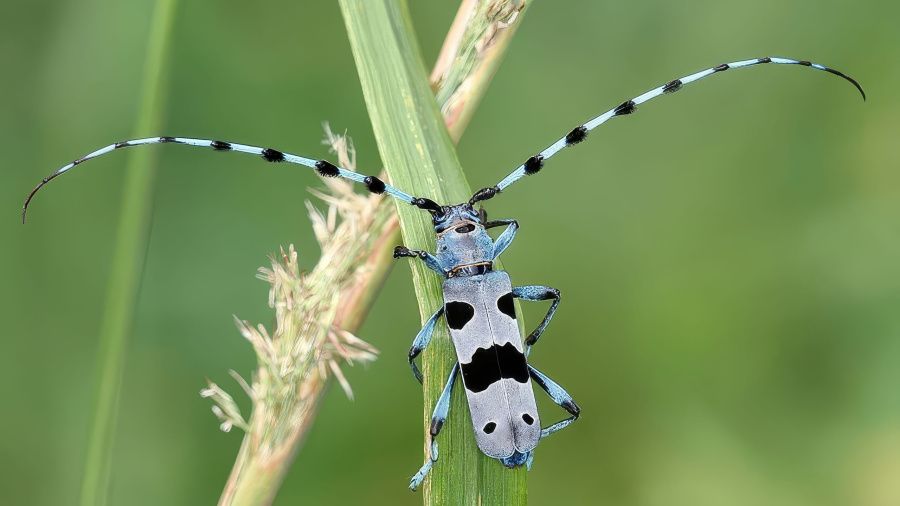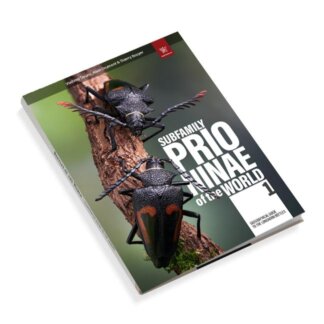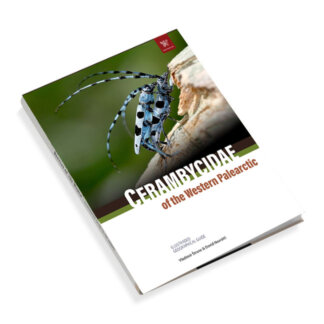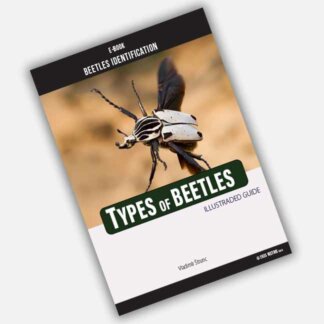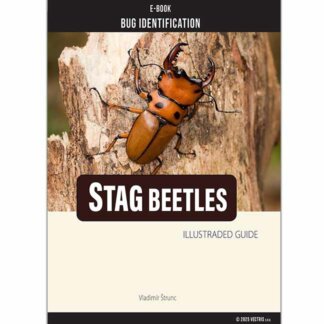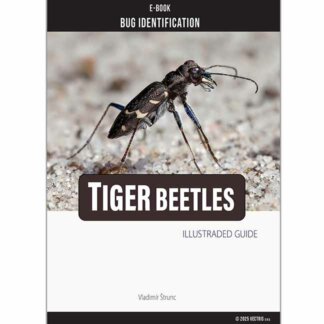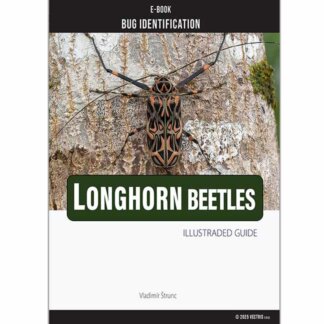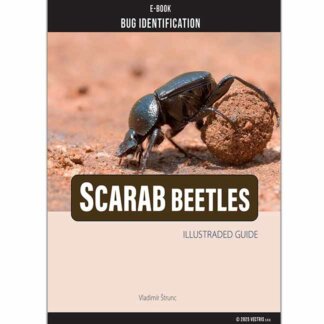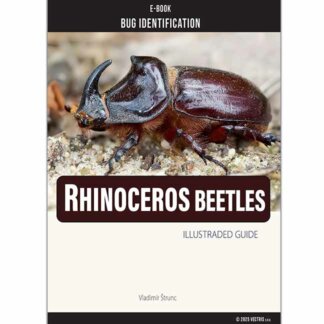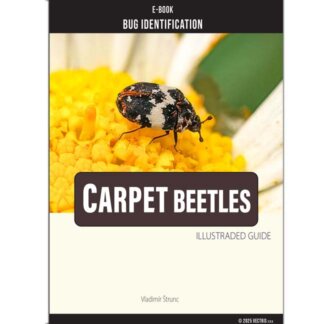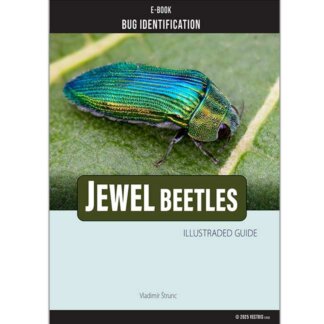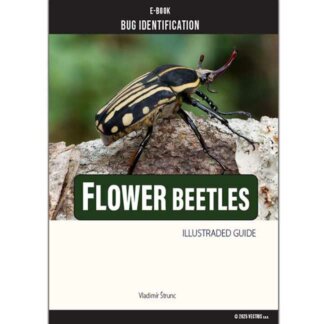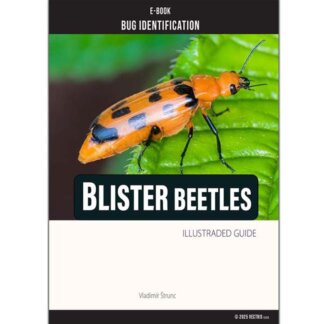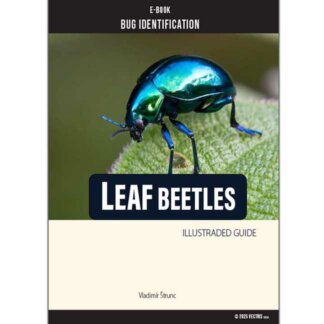Unique pictorial atlases for identifying Beetles. The family Cerambycidae, also known as the Longhorn beetles, is a very diverse group of beetles characterized by their long and slender bodies and particularly long antennae. The antennae are often as long or even longer than the body of the beetle itself. This family includes more than 35 000 species, which are found all over the world except Antarctica. Book about Beetles
Book novelties:
Prioninae of the World I., Cerambycidae of the Western Paleartic I. June Bugs,
Types of beetles insects
New E-Book: Ground Beetles, Tiger Beetles, Longhorn Beetles, Jewel Beetles, Stag Beetles, Carpet Beetles, Scarab Beetles, Rhinoceros Beetles, Weevil Beetles, Blister Beetles, Leaf Beetles, Flower Beetles,
Start Shopping, Start Saving – prices from $3 USD
Cerambycidae
We recommend:
jeweled beetles, ground beetles, longhorn beetles, goliath beetle, stag beetle, carpet beetles
Coleoptera
-
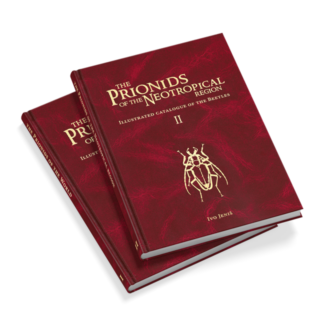 The Prionids Collection Bundle
Product on sale
€ 99.00
The Prionids Collection Bundle
Product on sale
€ 99.00
-
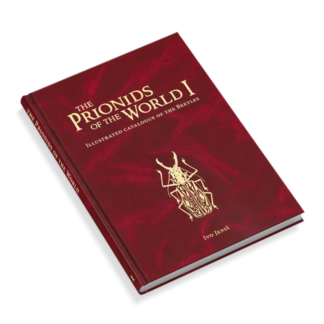 The Prionids of the World
Product on sale
€ 59.00
The Prionids of the World
Product on sale
€ 59.00
-
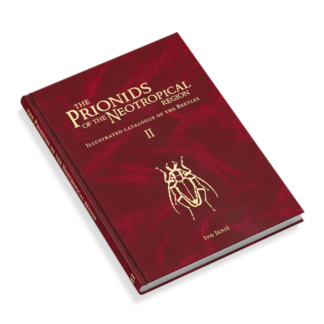 The Prionids of the Neotropical region
Product on sale
€ 59.00
The Prionids of the Neotropical region
Product on sale
€ 59.00
-
 The Prionids Collection BundleProduct on sale€ 99.00
The Prionids Collection BundleProduct on sale€ 99.00 -
 The Prionids of the WorldProduct on sale€ 59.00
The Prionids of the WorldProduct on sale€ 59.00 -
 The Prionids of the Neotropical regionProduct on sale€ 59.00
The Prionids of the Neotropical regionProduct on sale€ 59.00
Books about Beetles
Unique pictorial atlases for identifying Beetles:
(2020) Tiger Beetles of the World, Cicindelidae, Illustrated guide to the genera
(2023) Tiger Beetles of Africa, Cicindelidae, Geographical guide to the family Cicindelidae
(2024) Tiger Beetles of Orient, Cicindelidae, Geographical guide to the family Cicindelidae
(2022) Ground Beetles of Africa, Afrotropical Region
(2022) Jewel Beetles of the World, Buprestidae, Illustrated guide to the Superfamily Buprestoidea
(2008) The Prionids of the World, Prioninae, Illustrated catalogue of the Beetles
(2010) The Prionids of the Neotropical region, Prioninae, Illustrated catalogue of the Beetles
Family Cerambycidae: Longhorn Beetles
Cerambycidae
Key Characteristics
Body and Antennae: Longhorn beetles have elongated bodies and long antennae, which are a distinctive feature of the family. Some species may have shorter antennae, but they still possess the characteristic antennal sockets on low tubercles on the face.
Eyes and Legs: They have compound eyes that wrap around the antennae, and their tarsi are five-segmented, with the fourth segment being small and hidden.
Larvae: The larvae are legless, white, and wood-boring, often referred to as roundheaded borers. They play a crucial role in decomposing dead wood. Cerambycidae order
Distribution and Habitat
Longhorn beetles are found on all continents except Antarctica, with the majority of species inhabiting tropical regions of Asia and South America. They inhabit a variety of environments, from tropical rainforests to temperate forests and savannas.
Role in Ecosystems
These beetles are important in ecosystems as their larvae help decompose dead wood, recycling nutrients. Adults often feed on nectar and pollen, acting as pollinators. However, some species can be pests, causing damage to trees and wooden structures.
Subfamilies
The Cerambycidae family is divided into nine subfamilies, with the Cerambycinae and Lamiinae containing the majority of species.
Economic Impact
While not typically a direct threat to humans, certain longhorn beetles can cause significant economic damage by boring into wood, affecting agriculture, forestry, and lumber industries.
You can find here: Carabidae, Buprestidae, Cicindelidae, Scarabaeidae, Lucanidae, Chrysomelidae, Curculionidae, Staphylinidae
Interesting Species
One of the most notable species is the Titanus giganteus, known as the titan beetle, which is one of the largest insects in the world.
Family Coleoptera illustrated guide
Family Cerambycidae Latreille, 1802
Subfamily Prioninae Latreille, 1802
- Tribe Acanthophorini J. Thomson, 1864
- Tribe Aegosomatini J. Thomson, 1861
- Tribe Anacolini J. Thomson, 1857
- Tribe Cacoscelini J. Thomson, 1861
- Tribe Callipogonini J. Thomson, 1861
- Tribe Calocomini Galileo & Martins, 1993
- Tribe Cantharocnemini J. Thomson, 1861
- Tribe Catypnini Lacordaire, 1868
- Tribe Ergatini Fairmaire, 1864
- Tribe Eurypodini Gahan, 1906 (1868)
- Tribe Hopliderini J. Thomson, 1864
- Tribe Macrodontiini J. Thomson, 1861
- Tribe Macrotomini J. Thomson, 1861
- Tribe Mallaspini J. Thomson, 1861
- Tribe Meroscelisini J. Thomson, 1861
- Tribe Osphryonini Jin et al., 2023
- Tribe Parandrini Blanchard, 1845
- Tribe Prionini Latreille, 1802
- Tribe Rhipidocerini Jin et al., 2023
- Tribe Sceleocanthini Lacordaire, 1868
- Tribe Solenopterini Lacordaire, 1868
- Tribe Tereticini Lameere, 1913
- Tribe Vesperoctenini Vives, 2005
Subfamily Cerambycinae Latreille, 1802
- Tribe Acangassuini Galileo & Martins, 2001
- Tribe Achrysonini Lacordaire, 1868
- Tribe Agallissini J.L. LeConte, 1873
- Tribe Alanizini Di Iorio, 2003
- Tribe Anaglyptini Lacordaire, 1868 [NP]
- Tribe Aphanasiini Lacordaire, 1868
- Tribe Aphneopini Lacordaire, 1868
- Tribe Auxesini Lacordaire, 1872
- Tribe Basipterini Fragoso et al., 1987
- Tribe Bimiini Lacordaire, 1868
- Tribe Bothriospilini Lane, 1950
- Tribe Brachypteromini Sama, 2008
- Tribe Callichromatini Swainson, 1840
- Tribe Callidiini W. Kirby, 1837
- Tribe Callidiopini Lacordaire, 1868
- Tribe Cerambycini Latreille, 1802
- Tribe Certallini Fairmaire, 1864
- Tribe Chlidonini C.O. Waterhouse, 1879
- Tribe Cleomenini Lacordaire, 1868
- Tribe Clytini Mulsant, 1839
- Tribe Compsocerini J. Thomson, 1864
- Tribe Coptommatini Lacordaire, 1869
- Tribe Curiini J.L. LeConte, 1873
- Tribe Deilini Fairmaire, 1864
- Tribe Dejanirini Lacordaire, 1868
- Tribe Dichophyiini Gistel, 1848 165165
- Tribe Diorini Lane, 1950
- Tribe Distichocerini Pascoe, 1867
- Tribe Dodecosini Aurivillius, 1912
- Tribe Dorcasomini Lacordaire, 1868
- Tribe Dryobiini Arnett, 1962 H
- Tribe Eburiini Blanchard, 1845
- Tribe Ectenessini Martins, 1998
- Tribe Elaphidiini J. Thomson, 1864
- Tribe Eligmodermini Lacordaire, 1868
- Tribe Erlandiini Aurivillius, 1912
- Tribe Eroschemini Lacordaire, 1868
- Tribe Eumichthini Linsley, 1940
- Tribe Gahaniini Quentin & Villiers, 1969
- Tribe Glaucytini Lacordaire, 1868
- Tribe Graciliini Mulsant, 1839
- Tribe Hesperophanini Mulsant, 1839
- Tribe Hesthesini Pascoe, 1867
- Tribe Hexoplonini Martins, 2006
- Tribe Holopleurini Chemsak & Linsley, 1974
- Tribe Holopterini Lacordaire, 1868
- Tribe Hyboderini Linsley, 1940
- Tribe Hylotrupini Rose, 1983
- Tribe Ideratini Martins & Napp, 2009
- Tribe Lissonotini Swainson, 1840 H
- Tribe Luscosmodicini Martins, 2003
- Tribe Lygrini Sama, 2008
- Tribe Macronini Lacordaire, 1868 P
- Tribe Megacoelini Quentin & Villiers, 1969
- Tribe Methiini J. Thomson, 1860
- Tribe Molorchini Gistel, 1848
- Tribe Mythodini Lacordaire, 1868
- Tribe Necydalopsini Lacordaire, 1868
- Tribe Neocorini Martins, 2005
- Tribe Obriini Mulsant, 1839
- Tribe Ochyrini Pascoe, 1871
- Tribe Oedenoderini Aurivillius, 1912
- Tribe Oemini Lacordaire, 1868
- Tribe Opsimini J.L. LeConte, 1873
- Tribe Oxycoleini Martins & Galileo, 2003
- Tribe Paraholopterini Martins, 1997
- Tribe Phalotini Lacordaire, 1868
- Tribe Phlyctaenodini Lacordaire, 1868
- Tribe Phoracanthini Newman, 1840
- Tribe Phyllarthriini Lepesme & Breuning, 1956
- Tribe Piesarthriini McKeown, 1947
- Tribe Piezocerini Lacordaire, 1868
- Tribe Platyarthrini H.W. Bates, 1870
- Tribe Plectogasterini Quentin & Villiers, 1969
- Tribe Plectromerini Nearns & Braham, 2008
- Tribe Pleiarthrocerini Lane, 1950
- Tribe Plesioclytini Wappes & Skelley, 2015
- Tribe Protaxini Gahan, 1906
- Tribe Prothemini Lacordaire, 1868
- Tribe Psebiini Lacordaire, 1868
- Tribe Pseudocephalini Aurivillius, 1912 (1861)
- Tribe Pseudolepturini J. Thomson, 1861
- Tribe Psilomorphini Lacordaire, 1868
- Tribe Pteroplatini J. Thomson, 1861
- Tribe Pyrestini Lacordaire, 1868
- Tribe Rhagiomorphini Newman, 1841
- Tribe Rhinotragini J. Thomson, 1861
- Tribe Rhopalophorini Blanchard, 1845
- Tribe Rosaliini Fairmaire, 1864
- Tribe Sestyrini Lacordaire, 1868
- Tribe Smodicini Lacordaire, 1868
- Tribe Spintheriini Lacordaire, 1869
- Tribe Stenhomalini Miroshnikov, 1989
- Tribe Stenopterini Gistel, 1848
- Tribe Strongylurini Lacordaire, 1868
- Tribe Sydacini Martins, 2014
- Tribe Tessarommatini Lacordaire, 1868
- Tribe Thraniini Gahan, 1906
- Tribe Thyrsiini Marinoni & Napp, 1984
- Tribe Tillomorphini Lacordaire, 1868
- Tribe Torneutini J. Thomson, 1861
- Tribe Trachyderini Dupont, 1836
- Tribe Tragocerini Pascoe, 1867
- Tribe Trichomesiini Aurivillius, 1912
- Tribe Trigonarthrini Villiers, 1984
- Tribe Tropidini Martins & Galileo, 2007
- Tribe Tropocalymmatini Lacordaire, 1868
- Tribe Typhocesini Lacordaire, 1868
- Tribe Unxiini Napp, 2007
- Tribe Uracanthini Blanchard, 1853
- Tribe Vesperellini Sama, 2008
- Tribe Xystrocerini Blanchard, 1845
Subfamily Lepturinae Latreille, 1802
- Tribe Acmaeopini Della Beffa, 1915
- Tribe Caraphiini Ohbayashi et al., 2016
- Tribe Desmocerini Blanchard, 1845
- Tribe Encyclopini J.L. LeConte, 1873
- Tribe Evodinini Zamoroka, 2022
- Tribe Lepturini Latreille, 1802 H
- Tribe Necydalini Latreille, 1825
- Tribe Oxymirini Danilevsky, 1997
- Tribe Pidoniini Zamoroka, 2022
- Tribe Rhagiini W. Kirby, 1837
- Tribe Stenocorini J. Thomson, 1861
- Tribe Rhamnusiini Sama, 2009
- Tribe Sachalinobiini Danilevsky, 2010
- Tribe Teledapini Pascoe, 1871
- Tribe Xylosteini Reitter, 1913
Subfamily Spondylidinae Audinet-Serville, 1832
- Tribe Anisarthrini Mamaev & Danilevsky, 1973
- Tribe Asemini J. Thomson, 1861
- Tribe Atimiini J.L. LeConte, 1873
- Tribe Nothorhinini Zagajkevich, 1991
- Tribe Saphanini Gistel, 1848
- Tribe Spondylidini Audinet-Serville, 1832
- Tribe Tetropiini Seidlitz, 1891
Subfamily Lamiinae Latreille, 1825
- Tribe Acanthocinini Blanchard, 1845
- Tribe Acanthoderini J. Thomson, 1860
- Tribe Acmocerini J. Thomson, 1864
- Tribe Acridocephalini E.S. Dillon & L.S. Dillon, 1959
- Tribe Acrocinini Swainson, 1840
- Tribe Aderpasini Breuning & Téocchi, 1978
- Tribe Aerenicini Lacordaire, 1872
- Tribe Agapanthiini Mulsant, 1839
- Tribe Amphoecini Breuning, 1951
- Tribe Ancitini Aurivillius, 1917 P
- Tribe Ancylonotini Lacordaire, 1869
- Tribe Anisocerini J. Thomson, 1860
- Tribe Apomecynini J. Thomson, 1860
- Tribe Astathini J. Thomson, 1864
- Tribe Batocerini J. Thomson, 1864
- Tribe Calliini J. Thomson, 1864
- Tribe Ceroplesini J. Thomson, 1860
- Tribe Cloniocerini Lacordaire, 1872
- Tribe Colobotheini J. Thomson, 1860
- Tribe Compsosomatini J. Thomson, 1857
- Tribe Cyrtinini J. Thomson, 1864 H
- Tribe Desmiphorini J. Thomson, 1860
- Tribe Dorcadionini Swainson, 1840
- Tribe Dorcaschematini J. Thomson, 1860
- Tribe Elytracanthinini Bousquet, 2009
- Tribe Enicodini J. Thomson, 1864
- Tribe Eunidiini Téocchi et al., 2010
- Tribe Eupromerini Galileo & Martins, 1995
- Tribe Exocentrini Pascoe, 1864
- Tribe Forsteriini Tippmann, 1960
- Tribe Gyaritini Breuning, 1950
- Tribe Heliolini Breuning, 1951
- Tribe Hemilophini J. Thomson, 1868 [NP]
- Tribe Homonoeini J. Thomson, 1864
- Tribe Hyborhabdini Aurivillius, 1911
- Tribe Lamiini Latreille, 1825
- Tribe Laticraniini Lane, 1959
- Tribe Mauesiini Lane, 1956
- Tribe Megabasini J. Thomson, 1860
- Tribe Mesosini Mulsant, 1839
- Tribe Microcymaturini Breuning & Téocchi, 1985
- Tribe Morimonellini Lobanov et al., 1981
- Tribe Morimopsini Lacordaire, 1869
- Tribe Nyctimeniini Gressitt, 1951
- Tribe Oculariini Breuning, 1950
- Tribe Onciderini J. Thomson, 1860
- Tribe Oncideropsidini Aurivillius, 1922
- Tribe Onychogleneini Aurivillius, 1923
- Tribe Parmenini Mulsant, 1839
- Tribe Petrognathini Blanchard, 1845
- Tribe Phacellini Lacordaire, 1872
- Tribe Phantasini Kolbe, 1897
- Tribe Phrynetini J. Thomson, 1864
- Tribe Phymasternini Téocchi, 1989
- Tribe Pogonocherini Mulsant, 1839
- Tribe Polyrhaphidini J. Thomson, 1860
- Tribe Pretiliini Martins & Galileo, 1990
- Tribe Proctocerini Aurivillius, 1922
- Tribe Prosopocerini J. Thomson, 1864
- Tribe Pteropliini J. Thomson, 1860
- Tribe Saperdini Mulsant, 1839
- Tribe Stenobiini Breuning, 1950
- Tribe Sternotomini J. Thomson, 1860
- Tribe Tapeinini J. Thomson, 1857
- Tribe Tetraopini J. Thomson, 1860
- Tribe Tetraulaxini Breuning & Téocchi, 1977
- Tribe Tetropini Portevin, 1927
- Tribe Theocrini Lacordaire, 1872
- Tribe Tmesisternini Blanchard, 1853
- Tribe Tragocephalini J. Thomson, 1857
- Tribe Xenicotelini Matsushita, 1933
- Tribe Xenofreini Aurivillius, 1923
- Tribe Xenoleini Lacordaire, 1872
- Tribe Xylorhizini Lacordaire, 1872
- Tribe Zygocerini J. Thomson, 1864
Overview of Longhorn Beetles (Cerambycidae)
The Cerambycidae, commonly known as longhorn beetles, are a diverse family of insects characterized by their elongated bodies and long antennae. The correct Cerambycidae pronunciation follows the Latin rules of taxonomy. The family includes numerous Cerambycidae species, each varying in size, habitat, and ecological role. A Cerambycidae diagram can help illustrate the distinguishing features of these beetles.
These beetles are found worldwide, with species reported in Puerto Rico (Cerambycidae Puerto Rico), South Africa (Longhorn beetles South Africa), New Zealand (Longhorn beetles NZ), Texas (Longhorn beetles in Texas), California (Longhorn beetle California), Hawaii (Longhorn beetle Hawaii), Australia (Longhorn beetles Australia), and the United Kingdom (Longhorn beetles UK). They are also present in North America, including Northern California (Longhorn beetle Northern California) and Colorado (Asian longhorned beetle Colorado).
Physical Characteristics and Identification
A longhorn beetle close-up reveals intricate patterns on its exoskeleton. These beetles belong to the larger category of horned beetles, which also includes species such as the horned atlas beetle. Different types of beetles with horns exhibit varying adaptations, but longhorn beetles are distinguished by their exceptionally long antennae. The longhorn beetle face shows large, prominent mandibles that some species use for feeding or defense. The Cerambycidae size varies across species, with some reaching substantial lengths. Scientists use Cerambycidae identification techniques to differentiate between species, and resources like Cerambycidae BugGuide assist in classification.
There are multiple types of longhorn beetles, each with unique characteristics. The longhorn beetle scientific name varies by species, and some, like the Asian longhorn beetle scientific name, are well-documented due to their invasive nature. The Asian longhorned beetle size is relatively large compared to other species. The Asian longhorned beetle origin traces back to East Asia, but it has since spread to various regions.
Life Cycle and Habitat
The longhorn beetle life cycle includes four stages: egg, longhorn beetle larvae, pupa, and adult. The larvae, such as Cerambycidae larvae, Asian longhorned beetle larvae, and Sabertooth longhorn beetle larvae, bore into wood, making them significant contributors to forest decomposition but also potential pests. Images of longhorn beetle larvae photos showcase their cylindrical, grub-like appearance.
These beetles occupy a variety of habitats, ranging from forests to urban areas. The longhorn beetle habitat includes both living and decaying wood, and some species, such as the longhorn beetles and root borers, target tree roots. Their activity often results in longhorn beetle tree damage, particularly in non-native environments.
Ecological and Economic Impact
Due to their wood-boring nature, some species are considered pests. The Asian longhorn beetle damage is well-documented, as it poses a significant threat to hardwood trees. The Asian longhorned beetle damage extends to urban and agricultural landscapes, where it disrupts ecosystems. Additionally, Asian longhorned beetle tree damage affects commercial timber industries. Similar concerns exist for household infestations, with reports of house longhorn beetle damage causing structural issues.
The presence of longhorn beetles in my house is usually an indication of an infestation. Individuals often seek advice on how to get rid of longhorn beetles or, more specifically, how to get rid of longhorn beetles in house. There are various Asian longhorned beetle control methods, including Asian longhorn beetle control and Asian longhorned beetle treatment, which involve preventive measures and chemical treatments.
Interactions with Humans and Other Species
Many people wonder, do longhorn beetles bite, and while some species can bite, they are generally not aggressive. The longhorn beetle bite is not venomous, though their mandibles may cause minor injuries. Some individuals ask, do longhorn beetles sting, but these beetles lack a stinger. However, questions such as are longhorn beetles harmful, are longhorn beetles dangerous, longhorn beetle are they dangerous, and are longhorn beetles harmful to humans arise due to their wood-boring behavior rather than direct human threats.
Certain species raise concerns regarding toxicity, leading to queries like are longhorn beetles poisonous, are black and yellow longhorn beetles poisonous, and are Asian longhorned beetles poisonous. While they are not venomous, their impact on plant health leads to questions like are longhorn beetles harmful to plants. In general, beetles like the Queensland longhorn beetle Hawaii and others do not pose a direct threat to humans but can be detrimental to forests.
Predation and Control Measures
Natural longhorn beetle predators include birds, parasitic wasps, and other insectivorous animals. In regions where they become invasive, authorities implement Asian longhorned beetle control strategies to limit their spread. Treatment options such as longhorn beetle treatment and Asian longhorned beetle treatment involve a combination of biological and chemical methods.
Longhorn Beetles: A Threat or a Misunderstood Species?
Many people ask, are longhorn beetles bad, as they associate them with tree damage and infestations. While some species cause economic and ecological harm, others play a vital role in natural decomposition. Conservation efforts focus on balancing the need for forest health with the risks posed by invasive species. Understanding the longhorn beetle characteristics helps in managing populations effectively.
In summary, longhorn beetle types and longhorn beetle species exhibit remarkable diversity. Despite concerns about infestations and tree damage, these beetles contribute to the environment by aiding in the decomposition of dead wood. Questions like how long do longhorn beetles live depend on the species, but most have a lifespan ranging from a few months to several years. Their longhorn beetle location varies worldwide, with some species remaining localized while others, like the Asian longhorned beetle location, continue to expand. By studying these insects, researchers can develop better strategies for coexistence and conservation.
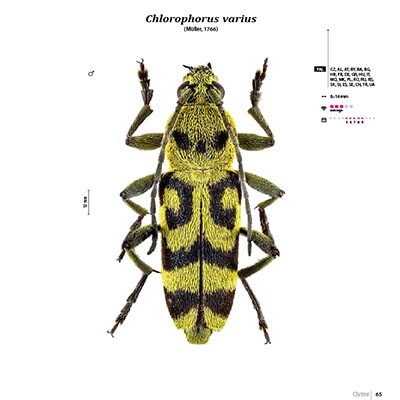
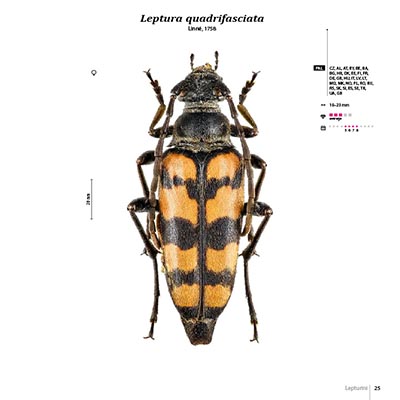
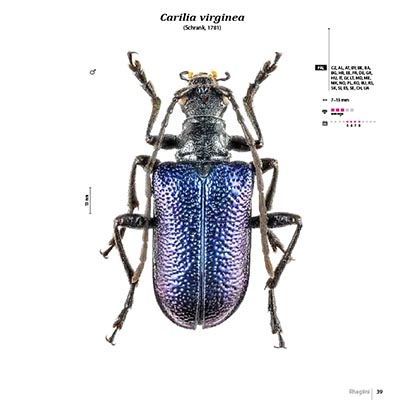
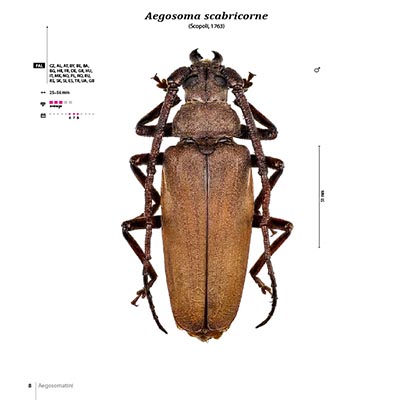
-
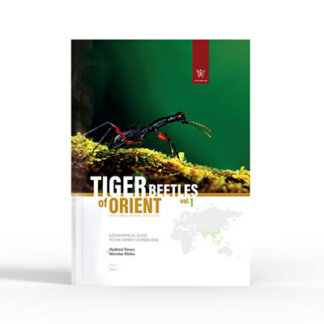 Tiger Beetles of Orient€ 129.00
Tiger Beetles of Orient€ 129.00 -
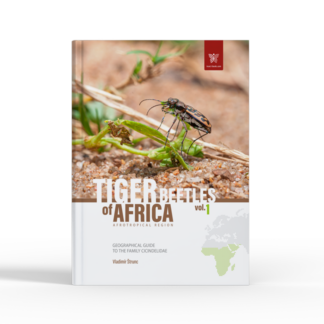 Tiger Beetles of Africa€ 129.00
Tiger Beetles of Africa€ 129.00 -
 The Prionids Collection BundleProduct on sale€ 99.00
The Prionids Collection BundleProduct on sale€ 99.00 -
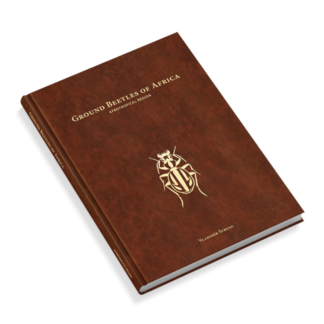 Ground Beetles of Africa (2nd edition)€ 136.00
Ground Beetles of Africa (2nd edition)€ 136.00 -
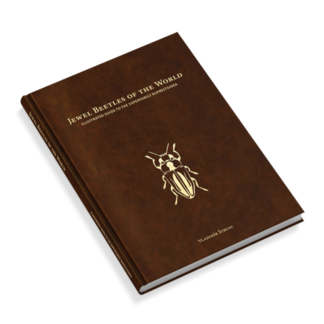 Jewel Beetles of the World€ 105.00
Jewel Beetles of the World€ 105.00 -
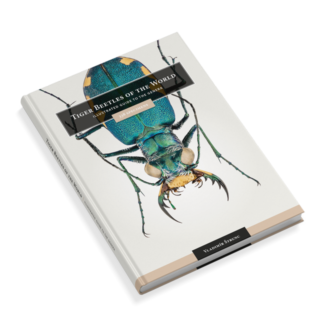 Tiger Beetles of the World€ 109.00
Tiger Beetles of the World€ 109.00
